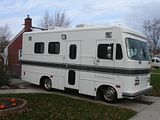Go to...  | Start A New Topic  | Search  | Notify  | Tools  | Reply To This Topic  |  |
 |
Had the a.c. recharged last summer and it worked great untill fall time when the cable froze up and it was stuck on hot. I fixed the cable and the potentiometer that controlls the speed of air flow but I now realise the a.c. is running really warm. I can heve the thing fixed, (recharged), by a buddy that owes me a favor or two but is this a problem that anyone suspects will reoccur every year? I hear all of these horror stories of how they never work or always break (which sounds like what has happened to me for the first year). Someone on the page recommended a "max air" system or something like that. Is this something you guys have tried and like? Any thoughts? | ||
|
Kris, thisblog might help you out. Ray and Anne Rv A/C Help 1990 Barth Regency 32RDGB1 Wide Body 3208 Cat 250 HP Gillig Chassis Center aisle | ||||
|
Captain Doom |
Roof air or dash air? Sounds like dash air; have it evacuated, recharged with oil and dye, run it and check for leaks. I had the cable problem, but also in another incident mice cut the wire to the AC clutch. Rusty '94 28' Breakaway: MilSpec AMG 6.5L TD 230HP Nelson and Chester, not-spoiled Golden Retrievers Sometimes I think we're alone in the universe, and sometimes I think we're not. In either case the idea is quite staggering. - Arthur C. Clarke It was a woman who drove me to drink, and I've been searching thirty years to find her and thank her - W. C. Fields | |||
|
 |
Dash air is correct Rusty. I am sure they pressure checked the system (or would like to believe they did), when it was refilled so I am hoping there is some other minor problem. Thanks for the lead Sky. | |||
|
Captain Doom |
The "pressure test" the technician does is rudimentary, and to quick to test for slow leaks. It's actually a vacuum test, where the system is evacuated prior to recharging. The vacuum is observed to hold, but that's only at 14 psi. Operating, the compressor suction pressure is ~30 psi and discharge is ~175-250 psi. The dye is the best way to localize a leak; the leak has to be pretty bad for a sniffer to detect it. The first suspect is the compressor (seals), then the expansion valve, then the lines. Rusty '94 28' Breakaway: MilSpec AMG 6.5L TD 230HP Nelson and Chester, not-spoiled Golden Retrievers Sometimes I think we're alone in the universe, and sometimes I think we're not. In either case the idea is quite staggering. - Arthur C. Clarke It was a woman who drove me to drink, and I've been searching thirty years to find her and thank her - W. C. Fields | |||
|
 |
Will do....How do you know all this stuff? | |||
|
| 1st month member |
I used to be an refrigeration tech and some of the sniffers are very good(very expensive), IMHO a lot better than any dye test. They can detect leaks in the PPM range that might take dye days to show up. 1999 Airstream Safari 25' 2007 Toyota Tundra 1987 Yamaha YSR toads | |||
|
Captain Doom |
I agree with Ed that some sniffers are very sensitive; however, my observations about A/C repair shops is that those in the North are far less inclined to spend the money when dye is cheaper and effective. Rusty '94 28' Breakaway: MilSpec AMG 6.5L TD 230HP Nelson and Chester, not-spoiled Golden Retrievers Sometimes I think we're alone in the universe, and sometimes I think we're not. In either case the idea is quite staggering. - Arthur C. Clarke It was a woman who drove me to drink, and I've been searching thirty years to find her and thank her - W. C. Fields | |||
|
| Powered by Social Strata |
| Please Wait. Your request is being processed... |
|
This website is dedicated to the Barth Custom Coach, their owners and those who admire this American made, quality crafted, motor coach.
We are committed to the history, preservation and restoration of the Barth Custom Coach.
We are committed to the history, preservation and restoration of the Barth Custom Coach.

